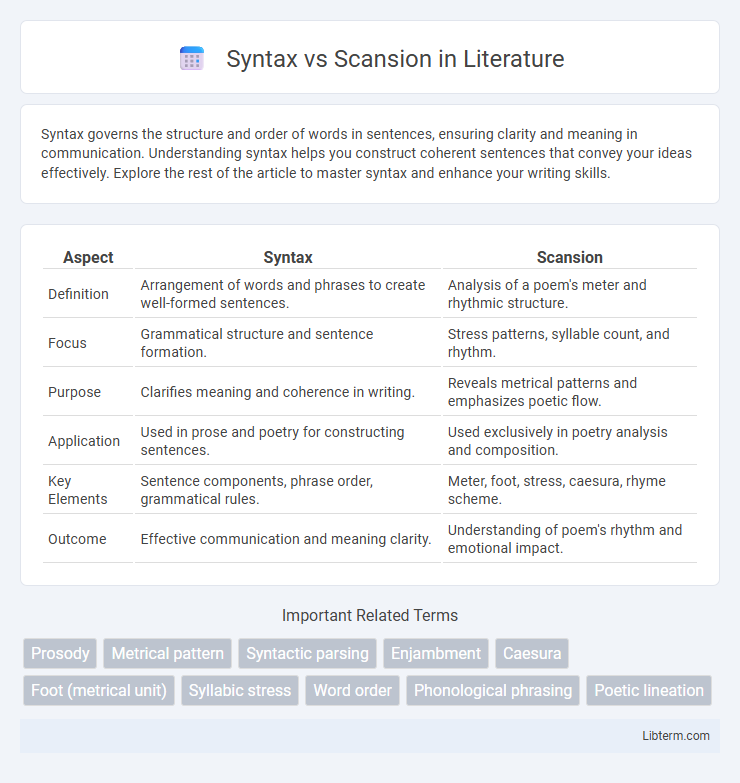Syntax governs the structure and order of words in sentences, ensuring clarity and meaning in communication. Understanding syntax helps you construct coherent sentences that convey your ideas effectively. Explore the rest of the article to master syntax and enhance your writing skills.
Table of Comparison
| Aspect | Syntax | Scansion |
|---|---|---|
| Definition | Arrangement of words and phrases to create well-formed sentences. | Analysis of a poem's meter and rhythmic structure. |
| Focus | Grammatical structure and sentence formation. | Stress patterns, syllable count, and rhythm. |
| Purpose | Clarifies meaning and coherence in writing. | Reveals metrical patterns and emphasizes poetic flow. |
| Application | Used in prose and poetry for constructing sentences. | Used exclusively in poetry analysis and composition. |
| Key Elements | Sentence components, phrase order, grammatical rules. | Meter, foot, stress, caesura, rhyme scheme. |
| Outcome | Effective communication and meaning clarity. | Understanding of poem's rhythm and emotional impact. |
Understanding Syntax: An Overview
Syntax refers to the set of rules and principles that govern the structure of sentences in a language, determining how words combine to form grammatically correct phrases and clauses. It shapes meaning by organizing sentence elements, influencing clarity and coherence in communication. Understanding syntax enables deeper analysis of language patterns, distinguishing it from scansion, which focuses on rhythmic and metrical patterns in poetry rather than grammatical structure.
Defining Scansion in Poetry
Scansion in poetry involves the systematic analysis of a poem's metrical patterns, identifying stressed and unstressed syllables to reveal its rhythmic structure. Unlike syntax, which governs sentence structure and word order in language, scansion focuses specifically on the meter and cadence of verses. Mastery of scansion enhances the interpretation and appreciation of a poem's formal qualities and auditory effects.
The Role of Syntax in Sentence Structure
Syntax governs the arrangement of words and phrases to create well-formed sentences, directly influencing clarity and meaning. In contrast, scansion analyzes the rhythmic structure of poetry by marking stressed and unstressed syllables without altering word order. Understanding syntax is crucial for constructing coherent sentences that convey precise ideas before applying scansion to assess poetic meter.
Scansion: Identifying Rhythm and Meter
Scansion involves analyzing poetry to identify its rhythm and meter by marking stressed and unstressed syllables within lines. This technique reveals the underlying beat, such as iambic pentameter or trochaic tetrameter, which shapes the poem's musicality and emotional impact. Understanding scansion enhances appreciation of poetic form and aids in interpreting a poet's intended emphasis and tone.
Syntax vs Scansion: Key Differences
Syntax governs the arrangement of words and phrases to create well-formed sentences, focusing on grammatical structure and meaning in language. Scansion analyzes the rhythmic structure of poetry by marking stressed and unstressed syllables to identify meter patterns. The key difference lies in syntax addressing sentence construction for clarity, while scansion dissects the prosodic elements that shape a poem's rhythm.
How Syntax Influences Poetic Meaning
Syntax shapes poetic meaning by controlling word order and sentence structure, which affects rhythm, emphasis, and interpretation within a poem. Deviations from standard syntax can create ambiguity or highlight specific themes, enhancing the emotional impact and complexity of the verse. Scansion analyzes meter and rhythm, but it is through syntax that poets manipulate language to evoke deeper cognitive and emotional responses.
The Impact of Scansion on Poetic Form
Scansion profoundly influences poetic form by revealing the underlying metrical pattern that shapes rhythm and sound within a poem. By analyzing stressed and unstressed syllables, scansion helps poets and readers understand how meter contributes to emotional tone and pacing. This metrical analysis distinguishes poetic structures such as iambic pentameter or trochaic tetrameter, directly impacting the poem's formal integrity and aesthetic rhythm.
Common Challenges in Syntax and Scansion Analysis
Common challenges in syntax analysis include ambiguous sentence structures, complex clause combinations, and varied word order that complicate parsing grammatical relationships. Scansion analysis faces difficulties in accurately identifying metric patterns due to irregular stresses, enjambment, and variations in poetic rhythm across different literary traditions. Both fields require careful interpretation of language nuances to resolve syntactic ambiguities and metrical inconsistencies effectively.
Techniques for Analyzing Syntax and Scansion
Techniques for analyzing syntax involve examining sentence structure, including phrase order, clause relationships, and grammatical functions to uncover how meaning is constructed in a text. Scansion techniques focus on identifying metrical patterns by marking stressed and unstressed syllables, determining the poem's rhythm and meter, such as iambic pentameter or trochaic tetrameter. Both analyses rely on close reading; syntax emphasizes grammatical and syntactic elements, while scansion prioritizes phonetic and prosodic features to reveal a work's deeper artistic effects.
Integrating Syntax and Scansion in Literary Interpretation
Integrating syntax and scansion in literary interpretation enriches the understanding of a poem's structure by revealing how grammatical patterns interact with rhythmic elements to convey meaning and emotion. Analyzing syntax highlights the arrangement of words and phrases, while scansion uncovers the metrical framework, enabling a deeper insight into the poet's deliberate modulation of pace, emphasis, and tone. This combined approach allows critics to decode complex layers of symbolism and stylistic choices, enhancing appreciation of the poet's craft and thematic intentions.
Syntax Infographic

 libterm.com
libterm.com